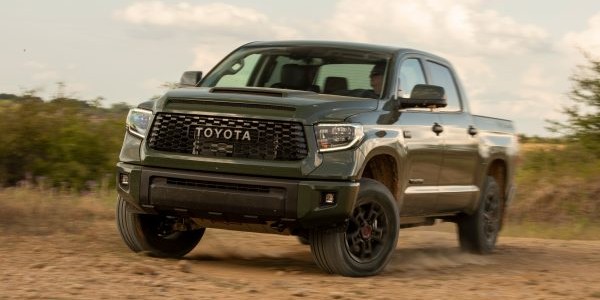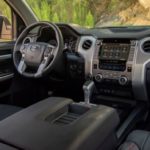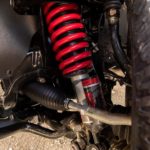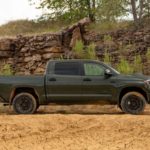By Jim Powell
When the press-fleet driver showed up in my driveway with a brand new 2020 Toyota Tundra TRD Pro, dressed up in the unmistakable color of Army Green, I did not know whether to salute or just keep my social distance. Just the look of this raised truck and special 18-inch TRD wheels express fun driving through the deserts or mountains or rivers anywhere in the world. After staying at home due to the Covid-19 Pandemic, I could not wait to take it for a spin.
I did not expect for this TRD Pro top-model Tundra 4×4 to be at home on the freeways surrounding Los Angeles. With 300 miles of highway driving, I believe this is one of the most comfortable riding trucks I have driven in years. Considering I have driven almost every production pickup sold in the USA since 1993, that is saying something. Toyota has dialed in the perfect suspension for a truck that can be used as a weekend warrior and a daily driver.
When trucks are rigged for towing and hauling, there are heavy-duty components necessary for the safety of the passengers and the cargo. When a truck is rigged for off-road duty, there are other articulating suspension components needed for uneven ground and traction in all circumstances. A truck capable of over 10,200 pounds of towing capacity and great off-road agility should not handle so well.
The Toyota Racing Division (TRD) Pro suspension consists of an independent TRD coil-spring high-mounted double-wishbone front suspension with a 2-inch lift. When trucks are lifted with after-market kits, it changes the geometry and weight distribution of the truck that has been manufactured with millions of dollars of R&D.
Toyota designed this Tundra TRD Pro from the ground up with large stabilizer bars and TRD Fox front shock absorbers with a piggyback reservoir. The rear axle is controlled with a trapezoidal multi-leaf suspension with staggered Fox shock absorbers. Additionally, all the Tundra TRD Pro pickup componants come with a warranty, and the whole truck is built in San Antonio, Texas.
The TRD Pro model also is very comfortable inside the cabin with thick leather seats accented with red stitching. The rear seat is almost limousine-like in legroom and headroom, and hip room is wide enough to hold up to 5 large adults. I was able to stow my golf clubs on the rear floor with the seats in place, and with room to spare. The new multimedia infotainment system is easy to use while the knobs and switches are large and intuitive.
The venerable 5.7-liter DOHC V8 still uses an aluminum block with 32-valve head. Horsepower is up to 381 at a high 5,600 rpm. Rarely will a driver push the accelerator this hard, but the 401 lb-ft of torque @ 3,600 rpm pulls hard. The six-speed automatic transmission is also tried and true and geared just right for this engine. Although it is debated daily in bars across America, there is nothing that sounds like a V-8 engine with dual exhaust pipes. The TRD exhaust system accentuates this point with a growl and burble, almost too loud under hard acceleration
Unfortunately, Toyota’s 5.7-liter powertrain has never been excellent on fuel mileage. I averaged 15.7 mpg on 87-octane fuel. EPA estimates a 13 city/17 highway/14 combined mpg for our 4×4 Tundra, so I beat the combined average by 1.7 miles-per-gallon. The “big three” truck builders have come a long way in higher mileage power plants while Toyota has dropped the smaller V-8 for the big boy. A larger 38.0-gallon fuel tank (Limited, Platinum, 1794 Edition, TRD Pro) does help on long trips.
The Tundra is available in sixteen configurations, including our test TRD Pro in a short-bed CrewMax 4×4. A 2020 Tundra can start out as a base work truck, albeit only in a double cab and only with the thirsty V-8. The starting price for a Tundra SR Double-Cab 4×2 is $33,575. Tundra is thousands higher than base standard cab trucks from Ford ($28,780 V-6) or Chevy (28,895 V-6). Ram (Dodge) has a standard cab work truck that starts around $31K, but none of these base trucks are popular or easy to find outside of fleet orders.
All Tundra’s come in a four-door cab with two cab sizes: Double Cab and CrewMax. The TRD Pro model gets the larger cab and the 5’ 7.2” bed. Our press fleet 2020 4×4 model came with all the goodies that Toyota offers, including a power tilt/slide moonroof and rear power window. Ours came with the few options available, i.e., spray-on bed liner, steel step rails, and paint protector film. Our test MSRP of $56,512 may seem high, but compared to the competition with similar configurations, the Toyota Tundra CrewMax TRD Pro is actually very competitive for all the equipment and capability in this package.
Toyota does not bother putting a 150 or 1500 badge on their truck as an indication of the Tundra’s capacity. The Tundra is closer to a ¾-ton truck in all the measurements that count for a truck owner. When scrutinized closely, there is no other light-duty truck that is over-engineered like the Toyota Tundra. Our Tundra has a published payload limit of 1,780 lbs. but I have seen Tundra’s safely haul and pull more than the numbers indicate. Heavy-duty disc brakes with oversized rotors and calipers are one reason that Tundra owners can depend on their trucks for heavy-duty work and play.
To keep up with consumer desires, Tundra now gets LED headlights with LED accent lights and an automatic leveling system (Limited). The TRD Pro has a manual level control and an auto high beam sensor. Attractive 18-inch BBS forged-aluminum TRD Pro wheels with tall Michelin LTX P275/65R18 tires complete the rugged look while providing a comfortable ride on-road and mountain goat traction off-road. Who needs 20-inch rims if one is climbing boulders on Saturday and hitting potholes on Monday?
Furthermore, Toyota includes almost all the driver-assist features offered. The Dynamic Radar Cruise Control (DRCC) and Lane Departure Alert (LDA) systems are all a part of the Toyota Safety Sense™ P (TSS-P). The Pre-Collision System with Pedestrian Detection [PCS w/PD] is not something normally tested on my drives, but I am glad to have it in heavy city traffic.
The Sway Warning System (SWS) was activated on purpose, alerting me to stay the course, while lane departure (steering) assist is not offered here. I wish Tundra came standard with a blind spot warning in the side mirrors. However, the best safety feature is actually a pickup that is stable in the corners, tracks where it is pointed, and gives the driver a clear field of vision all around the truck.
The TRD Pro with the hood-scoop and Army Green paint became the talk of my neighborhood. Sales numbers would show that Toyota has not been too competitive in the American full-size truck market against the big three. Now with Apple CarPlay and full infotainment integration, Tundra is more competitive, and a redesign is expected next year. While Ford, GM, and Ram (FCA) have a larger market share, Toyota builts a high-quality pickup that will outlast the payments.





